South Coast Orchid Society
Orchid Judging in Long Beach, 1954 and Beyond!
—
Orchid Digest Corporation Judging 1949-1967
AOS Judging in Southern California through 1980

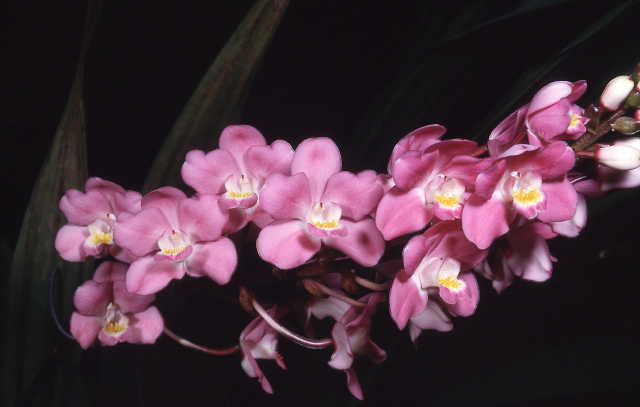
Eulophiella Rolfei 'Roke' FCC/AOS, the first award photo we recovered from AOS judging in Long Beach, February 26, 1968. The plant was exhibited by Emerson "Doc" Charles of Costa Mesa. After months of searching, we eventually were able to recover almost all of the 1968 award photos.
Formal judging of orchids in Southern California, by objective standards (a point system), was developed in the postwar years, especially through collaboration among members of the Orchid Society of California, the Orchid Society of Southern California (the two founding chapters of the Orchid Digest Corporation), and the American Orchid Society. A cadre of experienced judges soon developed in Southern California, using the Orchid Digest Corporation standards. The goal of identifying and recognizing superior orchids generated great interest in some of the new clubs that became Orchid Digest affiliates, including South Coast Orchid Society. Judging under Orchid Digest Corporation standards began at SCOS meetings in December, 1954, as a result of an earlier discussion and vote by the membership.
Judging under the auspices of Orchid Digest Corporation continued at the Long Beach site, first with certified judges "borrowed" from the Orchid Society of Southern California, and later with our own, home-grown judges, until December, 1967, when the ODC judging program was merged with the AOS judging program, which started at the SCOS meetings in Long Beach in January, 1968.
During the period when ODC standards were used, the judging team in Long Beach gave each award a sequence number, which, along with other award information, was regularly published in our newsletters and in some cases republished in Orchid Digest. Between the SCOS newsletters (we have recovered almost all issues from 1958 through 1973 — these were donated by Rita Crothers, probably to the library of the Orchid Digest Corporation, which was transferred later to the Huntington Botanical Center, where Brandon Tam brought them to our attention) and the reports of SCOS activities and ODC awards published in Orchid Digest, we have been able to reconstruct about 85% of the 522 awards conferred at Long Beach during that period.
The practice of assigning a sequence number continued when AOS judging started at our meetings in January, 1968, beginning again with 1. The sequence numbers continued to be used at least well into 1973, as the AOS awards were regularly published in our newsletters until late in that year. Eventually, not only the sequence numbers, but information about the awards themselves was dropped from our newsletters. Nevertheless, the existence of a numbered sequence of awards in our newletters, from 1 to 226, allowed us to compare the activities of the Long Beach judging center with the award records published in the AOS Bulletin, the Register of Awards (covering AOS awards up to the end of 1968) and its successor, Awards Quarterly (covering AOS awards 1969 until about 2006), a separate index, American Orchid Society Awards 1932-1989: A Combined Index (we will cite this as "AOS awards index 1932-1989") compiled by systematically extracting information from the Register of Awards and Awards Quarterly, as well as the AOS awards databases Orchids Plus and the current online database, OrchidPro.
We were also able to compare these records with information extracted into the proprietary OrchidWiz database, which contains award descriptions as well as photographs obtained from a variety of sources, including what have turned out to be some Long Beach award photos. We discovered that some awards conferred at the Long Beach site did not find their way into OrchidPro, or else had been miscopied or otherwise corrupted in ways that made them unrecognizable. At least a couple photographs in OrchidPro were attached to the wrong award records, and a number of "Long Beach" awards turned out to be from other judging sites.
As a result of these investigations, we can now present a relatively complete view of the Long Beach AOS awards for the 11 years 1968-1980 — a set of virtual orchid shows that have never been seen together before! The pictures are glorious, many of the exhibitors are well known from SCOS history (and in some cases, still with us). They show the activities of some of our most industrious members from the past, and remind us just how good the old orchids were.
Orchid Digest Corporation Judging at Long Beach, 1954-1967
Only a few award photographs have been recovered from Long Beach prior to AOS judging, although we expect there are more to be found. An official index of ODC awards was published, but it is little known and does not identify the judging center responsible for each award (our thanks to Tim Culbertson for alerting us to the existence of this index and sharing a copy with us). However, we thought the index might still allow us to identify some of the missing Long Beach awards, if enough of the awards from other ODC judging centers were published for that period in Orchid Digest, or if we happened to know something about the exhibitors and the award history of particular cultivars.
While more study of the Orchid Digest Corporation awards is needed, a few conclusions are possible. First, the status of judging at some ODC-affiliated sites may have been questioned or changed during some periods, notably for the Orchid Society of Southern California, whose judging program was considered "independent" for a time, and also for the Long Beach site. These peculiarities are still poorly known but might be clarified from the minutes of the meetings of the ODC Directors. Second, for those sites and events where both ODC and AOS judging took place for the same plants, it appears that the two judging programs may have shared a single photographer at each session. This policy seems eminently logical and efficient, and there is evidence that it occurred, as there are a number of small black-and-white award photos published in Orchid Digest that match exactly with the award photos for the same plant on the same date in OrchidPro. There are also examples where the photographs from the two sources differ slightly, as if the photographer made several exposures, and sent one to AOS and another to ODC. There are even a few cases where AOS seems to have more than one "award photo" for the same flower. While the use of a shared photographer does not help with the recovery of ODC award photos for the Long Beach site, since AOS judging was not occurring there, it is now possible to verify that some of the photos in OrchidWiz whose provenance is uncertain really do come from awards made at sites where ODC judging occurred.
American Orchid Society Judging at Long Beach, 1968-1980
Complete (?) list of AOS awards from the Long Beach judging center by year, 1968-1980, with photos and additional information from diverse sources:
AOS awards from the rest of Southern California, 1950-1980, with photos and additional information from diverse sources:
Orchid Digest Corporation Judging,
All Known Awards Using Point-Score System, 1949-1967
ODC awards from all sites (including those from OSSC and SCOS using the same standards), 1949-1967, with photos and additional information from diverse sources: It turns out that not all the awards found in the ODC Awards List (1952-1964, award numbers from 1 to 2313, but with some numbers missing) were published in Orchid Digest, leaving some awards from the Awards List without a venue and other information. Other groups of awards were published in Orchid Digest but did not find their way into the Awards List. Also, even after the ODC Directors decided in March, 1957 that judging at OSSC and SCOS was equivalent to "official" ODC judging, some groups of awards were still not published in Orchid Digest, and there is some additional uncertainty that all awards from the final year of ODC judging were eventually published. There are still questions about the status of some awards, but in round numbers, we were able to document over 3,500 awards, and found what appear to be verifiable ODC award photos for about 580 of them.
Some observations about the content of OrchidPro, as of October, 2022:
For awards before about 1968, the great majority lack the actual award date and other information. Most of the missing information (but usually not the award photos) can be recovered from official AOS publications. We think a thorough review of these awards against the published sources is worth the effort! While the award records in OrchidPro that fall into this category mostly pre-date AOS judging at the Long Beach site, they deserve special consideration in view of their historical importance.
As best we can determine from admittedly preliminary reviews of the early awards in OrchidPro, at some point an effort was made to transcribe award information for the very earliest AOS awards, presumably from the Register of Awards, into the first AOS award database, which came to be known to the orchid public about 2007 variously as AQ Plus, AQ Plus, or AQ Plus, and later AQPlus or AQplus. Individual award entries could have been altered at any time, but these efforts didn't get very far! We suppose that the data entry process was taking too long, and so, in order to make the database available as soon as possible to capture new awards, the expedient of entering only the data elements necessary for identification was adopted for the older awards, with the assumption that the rest of the data would be added at a later date. Place-holder information such as "unknown" was added (later?) to make these award entries more intelligible in subsequent versions of the database. As happens frequently when projects are curtailed due to time constraints, the omissions were never corrected.
As of the May, 2007 AOS Members Meeting held in Arlington, TX (Orchids 76(7):488 (July, 2007), in a report on that meeting by AOS President Carlos Fighetti), the project had progressed: "the AQ Plus computer program contains in its initial release approximately 40,000 images for awards given from 1971 to the present, with more to be added as they become available." Elsewhere, we found hints that the initial data entry, for the awards recorded from 1932 until at least 1989, was done by Dr. James R. Fisher of Vienna, VA, with further processing (from "floppy diskettes") by David A. Bishop, Sr., of Austin, TX, a collaboration that resulted in the publication of the AOS awards index (the edition we have covers 1932-1989, but there were other editions of the index, the last one known to us covering 1932-1999). Much later, in a review of how AOS has used technology, the genesis of AQPlus was credited to "a volunteer" (Orchids 90(2):114 (February, 2021)), perhaps referring to either Fisher or Bishop. While Fisher and Bishop were the first to apply computer technology to the awards data, they had only extracted enough of the data to identify the award. Adding the exhibitors, descriptions, measurements, and other data must have been the work of another cadre of unknown "volunteers".
The data elements that found their way into AQPlus for the older awards that were not completely extracted consisted of the Award Number (the award number may have been assigned during Dr. Fisher's original data entry process; it was never part of the Register of Awards, and the sequence of award numbers generally follows the order in which the awards appeared in the Register), the plant name, and the award designation and point score. It is not clear whether the parentage was also entered at this time; it might have been added later. Notably, several useful data elements in the published awards index were not included.
The fictitious data values that now appear in OrchidPro for this group of awards include: Award date is shown as Jan 01, 1965, even though the true year for each award is normally contained in the first four digits of the award number. There are currently (October, 2022) 6,220 such awards, of which about 1,620 have color photos attached, although it is known that some of those photos are incorrect. Exhibitor is shown as Unknown Exhibitor. In other parts of the AOS records and publications, the exhibitor is often termed the grower. Photographer is shown as Unknown Photographer, whether or not a photograph is present. Event is shown as Predated AQplus Centers. Judging Center is shown as Predated AQplus Centers. All measurements are shown as 0, 0.0, or - (in other words, missing values). Description is shown as No descriptive information provided.
The original awards database certainly did not have the capability to include photographs. There are references in the Bulletin and elsewhere of a separate "awards data base" and an "image data base" that were in the process of being combined in 2007-2008 to create AQPlus. Digitized photographs were added to the text-based entries in the "awards data base", and for the early awards, those digital images were created by scanning the award slides, probably around 2006 (we found one statement that AOS "acquired" these images in 2006). Some scans were excellent, others very poor. The digital image files were organized into an "image data base" using Portfolio image management software (mentioned in a committee report, October, 2008).
The history of the awards database can be traced further back in an article by Howard Bronstein, an accredited judge and at that time the chair of the AOS Information Committee, in the "Judges' Forum" section of Awards Quarterly 29(1) (March, 1998), reproduced on the AOS web site without other bibliographic data. Bronstein mentions his first involvement in the effort about 1995: there was an old dBase II program containing awards back to 1986; slides were catalogued separately and stored in large slide trays. A new program, written by Bronstein and Ursula Hoffman in Microsoft FoxPro, integrated several steps in the awards process, including capture of slide data (that is, data concerning the existence of award slides, not the images themselves). This program was deployed about 1996, and by early 1998, had been operating successfully. By that time, they had also managed to capture historical awards data back to 1970, and they were preparing to create a new version of the program in Visual FoxPro 5.0, at that time the latest compatible database management software. One result of these efforts was a CD issued in 2002, American Orchid Society Awards, 1932-2001, which we have seen in bibliographies only.
How the scanned images were matched to the award records is not known, since the award slides had necessarily arrived at AOS headquarters without award numbers. Understandably, some errors were made, with the result that the award photographs sometimes turn out to be an entirely different plant, or the wrong cultivar of the stated hybrid or species, or an image from a different award for the same cultivar.
How can the missing data be recovered? We believe such a project is feasible, but if it is to be undertaken, a reasonable effort to make sure the information is correct will be required. The project should include: Reconcile the Register of Awards with the published award lists in the AOS Bulletin, annotating a master copy of the Register to capture the corresponding Bulletin volume and page numbers. This is necessary because we have identified a few examples of awards that were omitted from the Register or attributed to the wrong judging center or event, and at least some of these errors have been carried forward into OrchidPro. The data in the Register appear to be almost entirely correct, but it is possible there are instances where the Bulletin contains a cultivar name, point score, description, or measurements that were omitted from the Register. Add citations to the master copy of the Register to indicate award photos that were published in the Bulletin as part of the official publication of the awards. The small black and white photos that were published with some awards provide a means to verify that the color images in OrchidPro are the correct photos! Transcribe data from the Register (including the annotations recommended above) into a data entry form suitably formatted for ease of use, including automatic conversion of measurements in inches and 1/16" fractions to centimeters and tenths. Other conversions (designations of judging centers or events, for example) may be needed as well, for compatibility with usage in the current database. Citations of the original award publication, and of the accompanying photo if any, should be included as a separate data element or appended to the description. Develop, test, and deploy a program or process to load the extracted data into OrchidPro one award at a time, providing a side-by-side comparison of the extracted data and the current content of the matching OrchidPro record before the update is accepted, and flagging any discrepant entries for further review. Addition of color photos from scanned award slides or other sources should be a separate project, but it is important to create and preserve good quality digitized images before award slides deteriorate further. Judging centers and the judges themselves should be made aware of the importance of preserving any verifiable award slides that may still exist outside of AOS collections. A further project will be needed to locate and correct errors involving at least the early years of Awards Quarterly, where there are frequent problems involving duplicate award numbers (see below), attribution of awards to the wrong event or judging center, and various other discrepancies. Awards from 1968 through at least part of 1975 were published first in the Bulletin, and then republished in Awards Quarterly, so it is necessary to reconcile these two sources with each other in order to establish what information should appear in OrchidPro. Errors involving award photos are also known in these sources. The general requirements of such a project will closely follow those described above, including citations of the places where each award photo was published.
A few awards that were officially published are found in OrchidPro under an incorrect award date, or an incorrect location, or some other combination of erroneous data that makes them difficult to find. There are even cases where the award is correctly identified, but the description clearly comes from some other award.
A few awards that were officially published are not found in OrchidPro in any form.
For the years 1974 through most of 1978, at least for the Long Beach judging site, most awards in OrchidPro are not accompanied by photos, even though we believe that the photos were made and were distributed in the form of color slides. For the last couple years in this period, photos for AM and FCC awards, but generally not for HCC awards, were published or found their way into the database.
The Huntington Botanical Center now holds the donated collection of color award slides from the AOS Pacific South regional judging program. The search for the missing award photos remains to be completed, but the results so far are impressive: about 80% of the photos that were either missing or of very poor quality in OrchidPro that were on our first search list have been found, and almost all of them proved to be of good quality.
Some award photos have turned up among images contributed to OrchidWiz (notably by Steve McNerney and William Merritt), in the form of excellent scans with superior color and resolution. Many of these are mirror images of the photos now in OrchidPro, which suggests that scans have sometimes been made without attention to the correct orientation of the color slide.
Many award photos were later published as illustrations for articles in the AOS Bulletin. Some of those illustrations involve photos that are not found in OrchidPro, although the quality of the published illustrations varies tremendously. With careful attention to the award history of individual cultivars, it is often possible to establish with reasonable certainty that the illustrations are in fact from the original award photos. We have been able to confirm some of these from the color slides. However, we have already encountered several awards where there is no photo in OrchidPro, and no slide has been found, but the award photo was published in the AOS Bulletin or Orchid Digest. Were these slides loaned out from the Pacific South collection but never returned, or might they just be misfiled?
The quality of the award photos found in OrchidPro varies tremendously. Some derive from very poor scans made many years ago, possibly from badly faded color slides, but more likely due to technical issues in the preparation of the scans. In other cases, the scans appear to be of good quality, but the slides themselves are badly faded. New scans from the color slides should be made. We had occasion to examine some award slides that were found by the family of a former AOS judge in Long Beach, dates ranging from 1977 to the 1980's, none of which showed any evidence of fading, from which we were able to make excellent digital images using an inexpensive film scanner. In fact, there are several distinct problems evident in the Pacific South Region's collection of award slides, in addition to the problems noted above: From many sources, we know that the slides are almost certainly duplicates of the originals (at one point, the judging centers were required to send 12 duplicates to AOS headquarters — are the originals still maintained there as a separate collection?), and there is clear evidence that the copies were not always prepared with care. Photographs of whole plants are often not correctly illuminated, resulting in badly overexposed flowers (frequently with no markings visible at all) and very dark foliage. Some slides are badly overexposed, especially for white or pale flowers (e.g., many Phalaenopsis), to the point where the original color and pattern cannot be recovered at all. Some slides show extreme color saturation (reds, and sometimes yellows), resulting in tones that do not match the descriptions. We found examples where OrchidPro has a well-balanced photograph (although the tone is frequently not ideal, and many of the photos are too dim), but the award slides (duplicates) are badly overexposed or show major distortions such as oversaturation. Some photos from awarded plants published in the AOS Bulletin are vasty better than the award slides. Clearly, the editors of the AOS Bulletin had access to the original slides or else to better copies. The slides from the Long Beach site bear a sequence number on the reverse, matching the sequence numbers that were published in the SCOS newsletters 1968-1973. All of the Long Beach award photos for the genus Lycaste for the period of our search, and indeed, for all of the Pacific South region for that period, are missing from the collection. The same situation is found for some very famous hybrids, such as Cymbidium Lillian Stewart and Laeliocattleya Bonanza (now Cattleya Bonanza (Bracey)). They might be misfiled in some other part of the alphabet, or they might have been loaned out to someone writing an article, or for some other purpose, and never returned. Perhaps not coincidentally, quite a few of the hybrids found on a 1986 list of the most awarded orchid hybrids (Awards Quarterly 18(4):209ff (Fall, 1986), Philip W. Andrews, "Orchids with 20 or More Quality Awards") are those for which at least the early AOS award slides are missing from the Pacific South collection. Perhaps someone "borrowed" them for a slide show?
For Paph and Cymbidium awards from the Long Beach site, the same flowers were often judged and awarded within a few days at separate CSA judging, so that CSA photographs of the same flowers can be found, either contributed to OrchidWiz or published by CSA in Orchid Advocate. The latest information we have indicates that the Cymbidium Society of America has ceased judging, publication, and other activities, but has not yet dissolved or liquidated its assets. To the best of our knowledge, it should be acceptable to use CSA award photographs that have been donated to OrchidWiz with appropriate credit. We have not yet done so, as we expect to find most of the photos in the AOS awards slide collection.
Overall, we estimate that about 18% of the AOS awards from the Long Beach site prior to about 1980 have or had some sort of data problem in OrchidPro (not counting issues with the photos). If that figure is at all representative of what has happened to awards from other sites, a thorough audit of the data would be useful. For the Long Beach site, we have a nearly complete record of the AOS judging activities from 1968 through 1973, published in the SCOS newsletter, because the judging team assigned a serial number to each award. OSSC also maintained a sequence number for its awards, whether they made under "independent" judging, or ODC or AOS standards. For other sites, the awards published in the AOS Bulletin, the Register of Awards, and its successor Awards Quarterly should be regarded as the official record of awards, that should match OrchidPro, and should serve as a basis for identifying photos and resolving data issues.
We found numerous examples in the Bulletin and in Awards Quarterly where groups of awards from different events or venues were assigned the same award numbers. It appears that the compilers of the AOS awards index 1932-1989 were aware of this problem (the duplicate numbers would have become apparent when the records extracted from Awards Quarterly were sorted by award number) and that some attempt had been made to resolve the duplications, by assigning different award numbers so that each entry had a unique number, even though that procedure caused the award numbers in the index sometimes to differ from what is found in Awards Quarterly. Unfortunately, these corrections were not always carried successfully into the later awards databases, including the current version, OrchidPro. Many of the original duplicated entries from Awards Quarterly have instead suffered a variety of fates, such as being conflated, assigned to other numbers, or, not infrequently, being omitted entirely.
From time to time, corrections were published in Awards Quarterly. It is not clear yet whether the published corrections were accounted for in the AOS awards index for 1932-1989. The corrections need to be checked.
In addition to the errors already noted, we discovered some award records in OrchidPro that cannot be retrieved by a "long beach" location or event search, but which are attributed to the Long Beach judging site on a date corresponding to our normal meeting schedule when the record is displayed in OrchidPro. Also, some OrchidPro records attribute an award to Long Beach, but the awards are nevertheless found to come from other sites and on other dates in the AOS Bulletin and/or Awards Quarterly. There are a number of other complicated situations where "location" or "event" data are misleading or inconsistent in various ways. A fairly typical oddity of this type is that a search for the location "hollywood" retrieves a single entry (award number 19550001), which, when displayed, does not contain the text "hollywood" at all. Also, a large number of awards (but almost always occurring in the month of April!) turn out to show two different award dates, one day apart, in the summary and detail sections of the award display. Some of these anomalies might be explained if the OrchidPro database contains additional data elements that are used in searches but not displayed to the OrchidPro user, an unfortunate design choice that would make error correction unnecessarily difficult. Each such record needs to be investigated carefully, and corrected in such a way that the location, event, and similar searches will behave as expected. In order for that to happen, all data elements must be accurately displayed and accessible for correction — even if that requires a new data interface.
The examples where it has been established that the wrong photo is attached to an award in OrchidPro were mainly discovered accidentally. For the most part, we looked for award slides only when there was not already a good quality photo in OrchidPro, or, less frequently, where OrchidPro had a photo that was doubtful or obviously incorrect. There could easily be more photos in OrchidPro that are attached to the wrong award. In order to detect these, it would be necessary to locate and scan the award slides for every record in OrchidPro, and also to compare them with the photos published in the AOS Bulletin and Awards Quarterly. If a comprehensive audit of OrchidPro is ever undertaken, comparison of all available photos will be an important component of the project.
Further Observations on ODC Awards and the ODC Judging Program
The index of ODC awards covering October, 1952 through December, 1964 has been extracted. We have also added the awards from January, 1965 through December, 1967 that were published in Orchid Digest, as well as records from other sources, including "independent" judging by OSSC. It has been possible to identify high-resolution versions of some of the award photos as well, where a small black-and-white award photo published in Orchid Digest can be shown to match an award photo from the same judging session that appears in AOS records. Also, a handful of ODC award slides have turned up in materials donated to the Huntington Botanical Center.
The history of Orchid Digest Corporation judging is more complex than it first seems. An awards list was published covering what could be considered "official" ODC awards from October, 1952 through December, 1964. Almost every award in this list bears a sequence number, although there are some errors that have been discovered by extracting the data to a spreadsheet and sorting in various ways. The earliest awards in this list are from the first three Western Orchid Congresses, which brings the list up to November, 1954. Notably, the award designations in this list were all translated to "modern" terminology, so that Bronze, Silver, and Gold certificate awards are all listed as HCC, AM, and FCC awards, respectively. This change in terminology had actually occurred in March, 1956, at least for OSSC, where we have a long run of the monthly newsletters, showing the original award information.
In December, 1954, the first awards from individual ODC affiliate societies appear, for the Orchid Society of California, in Oakland. That same month, SCOS began judging under ODC standards, but those awards were not published as such in Orchid Digest (they were noted in a meeting summary published separately, and from the context, were clearly intended by SCOS as "real" ODC awards). OSSC had been recording awards since September, 1949, but those were not published in Orchid Digest, nor are they listed in the ODC awards list until considerably later. However, the January, 1955 awards from SCOS were published as "real" awards in Orchid Digest, and are included in the ODC awards list.
After January, 1955, neither OSSC nor SCOS awards were published, until November, 1956, when one of the OSSC awards was published in Orchid Digest. Next, January through April, 1957 OSSC awards appeared in Orchid Digest, but not the May awards. Beginning in May, 1957, however, SCOS awards began to be published regularly, as did, for the most part, OSSC awards. In fact, a notice appeared in Orchid Digest, reporting a decision made at a Directors' meeting in May, 1957, to the effect that judging by OSSC and SCOS was to be treated as ODC judging, but without any further explanation. Nevertheless, some of the OSSC and SCOS awards were not published in Orchid Digest, and some are not found in the ODC awards list. The omissions can be established because of newsletters and summary meeting reports, as well as the OSSC awards list covering 1949 through September, 1958, which uses the original designations.
The OSSC newsletters have their own quirks. For some months, judging reports mention AOS judging only, even though the awards are also found in the ODC awards list. For some awards, and presumably these are only the awards where the AOS point score was different from the ODC/OSSC score, both scores are reported separately, and they sometimes differ significantly.
More puzzling, there are some cases (before the switch to the "modern" terminology in March, 1956) where the point score is at odds with the stated award. In this way, a number of plants where the point score was 80 or higher are nevertheless shown as Bronze awards, and there seem to be too many of these to be due to clerical errors. On further research, it turns out that the original point system used 82.0 as the breakpoint between "Bronze" and "Silver". The breakpoint was eventually changed to 80.0, where it has remained in AOS judging to this day.
Finally, after the ODC judging program was merged with AOS judging in January, 1968, there remained a number of awards that had still not been published. Efforts were made to deal with these, but when the last group of awards was published in July, 1969, some from 1967 or even earlier had apparently still not been published, and no further effort was made to complete the publication of ODC awards.
It will be seen that no single source can be considered authoritative; there are errors in the newsletters, the OSSC awards list, Orchid Digest, and the ODC awards list. About the best that can be done is to look for a consensus and a reasonable explanation for the discrepancies that are found. Some help is available from AOS award records, because the AOS awards from OSSC will generally have counterparts in ODC records. It is likely, also, that more of the pre-1968 OSSC newsletters will eventually turn up.
For award photos, it appears that only one set of photographs was made (in the form of color slides) at monthly judging sessions for some sites. We know what the ODC award photos looked like, because many were published as small black-and-white images along with the award information in Orchid Digest. Matching black-and-white or color images in the AOS Bulletin and the OrchidPro database show that the same award photos were used to document both sets of awards, ODC and AOS, although there are other examples where the ODC and AOS award photos differ slightly, evidently selected from a series of slides taken of each awarded plant.
Recovering "Lost" Award Photos: A Test Case
20 "Lost" Photos for Dr. Norito Hasegawa's Awarded Plants from Long Beach judging, 1968-1980
We were surprised to discover that so many of Norito's awarded plants from AOS judging at Long Beach lacked photographs entirely, and there were several that, while they had photos in OrchidPro, the color was exceptionally bad. There was also one award where we found a black and white photo in Awards Quarterly, but the color photo was not found in OrchidPro. Brandon Tam gave us access to the Pacific South award slides collection at the Huntington Botanical Center, where we quickly found 15 of the 20 problem photos from Long Beach, presented below.
(An additional 25 awards given to Norito's plants at other judging sites also lack photos, which we will research as time permits. One point of this exercise is to illustrate how the lack of photos, most of which can be found, detracts from the accomplishments of orchid growers.)
March 25, 1968, Long Beach
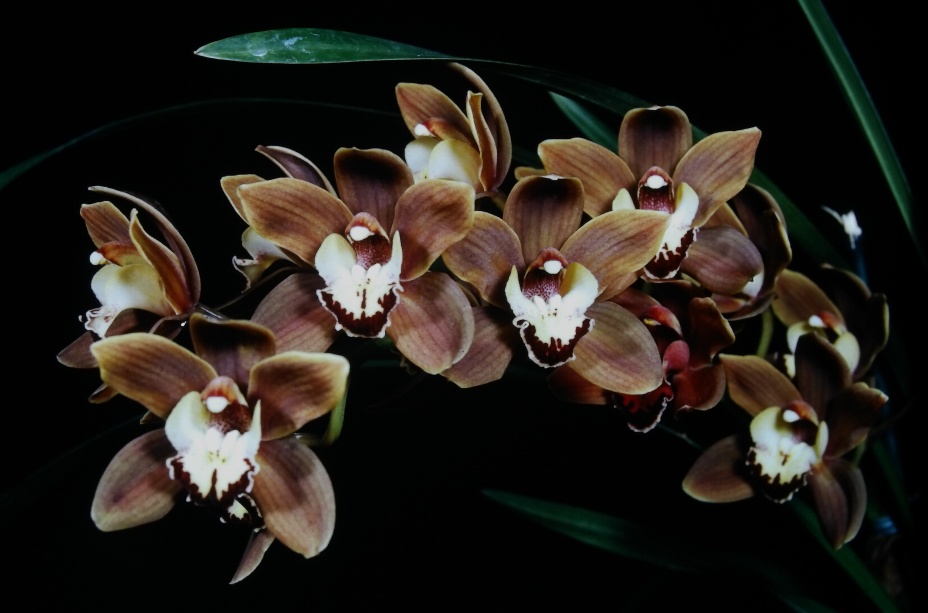
Cym. Mimi 'Mocha' HCC/AOS, new scan from Pacific South Region award slide collection
23 Cym. Mimi 'Mocha', HCC/AOS 76.7 points, Norito Hawegawa. AOS Award No. 19680245, listed in OrchidPro with date January 1, 1965, no other useful data. This plant received BM/CSA the next day, March 26, 1968, with color photo. Published in AOS Bulletin 37(11):1015, November, 1968. Award text: "Fifteen tawny brown flowers on one spike; cream-white lip with black-maroon edging and stripe at center of lip. Natural spread of flower 2½"; dorsal sepal ¾" wide, 1-9/16" long; petals ⅝" wide, 1½" long; lateral sepals ⅝" wide, 1½" long; lip 15/16" wide, ¾" long", exhibitor Dr. and Mrs. Norito Hasegawa, Orange, CA.
December 28, 1970, Long Beach
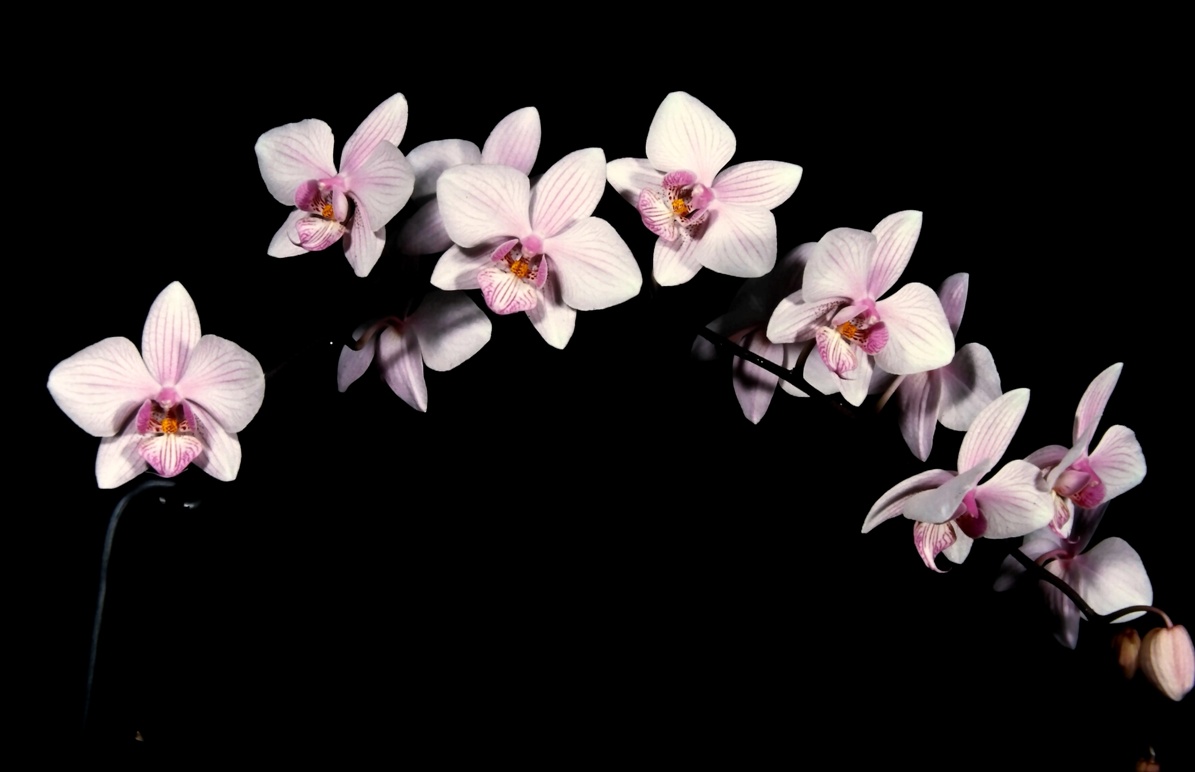
Phal. Ann Linden 'Lisa Hasegawa' HCC/AOS, new scan from Pacific South awards slides
142 Phal. Unnamed 'Lisa Hasegawa' (Phal. Ann Lovelace × Phal. lindenii), HCC/AOS 75.0 points, Dr. N. Hasegawa. Hybrid is Phal. Ann Linden, originated and registered in 1972 by Hugo Freed, Malibu, CA. AOS Award No. 19700697. OrchidPro has complete information but no photo. Published in AOS Bulletin 42(6):54, June, 1973, and in Awards Quarterly 4(3):70 (1973) without a photo. Award text: "Thirteen flowers with eleven buds on one spike; delicate, near-white, overlaid with a rayed pattern of pink veins on tepals; lip with same pattern of darker veins", exhibitor Dr. Norito Hasegawa, Orange, CA.
March 27, 1972, Long Beach
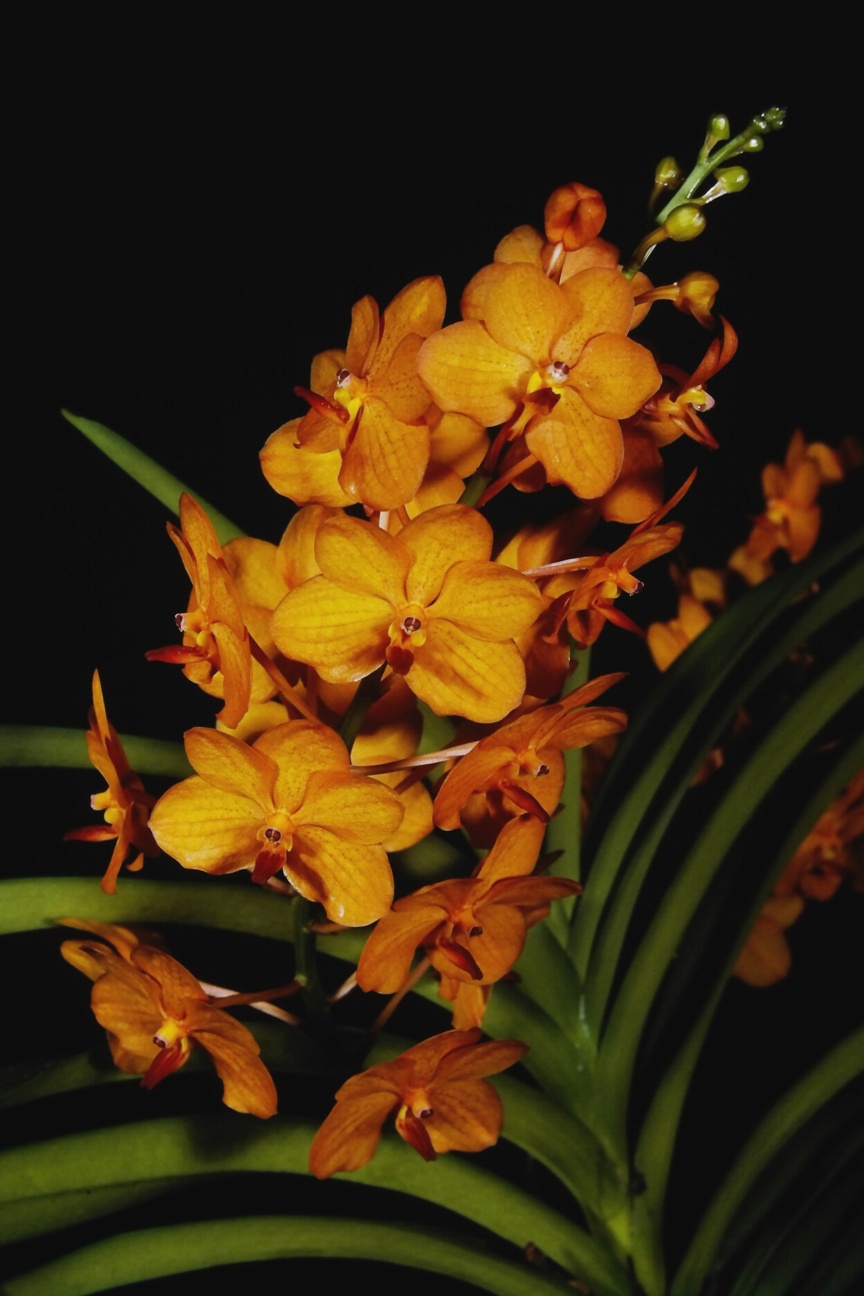
Vanda Meda Arnold 'Caramel' HCC/AOS, new scan from Pacific South award slides
187 Ascda. Meda Arnold 'Caramel', HCC/AOS 76.3 points, Dr. and Mrs. Hasegawa. Now correctly Vanda Meda Arnold. AOS Award No. 19720272. OrchidPro has complete information and color photo. Published in AOS Bulletin 41(12):1113, December, 1972, and Awards Quarterly 4(1):11 (1973) with black and white photo. Award text: "Forty-two flowers plus twenty buds on two spikes; bright-orange sepals and petals with reddish stripes and spots; lip yellow with dark-brown tip", exhibitor Dr. and Mrs. Norito Hasegawa, Orange, CA. Award photo is too dark and the color is far less saturated than the description suggests.
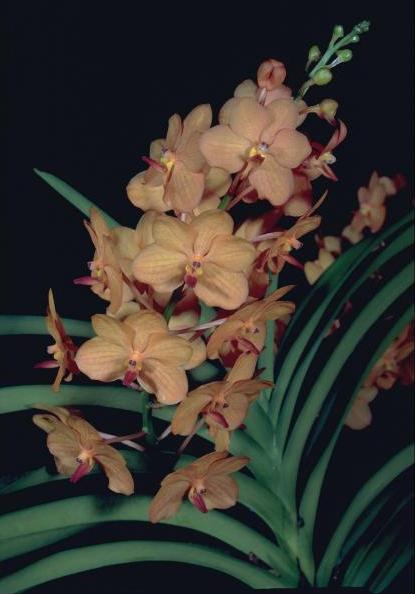
Vanda Meda Arnold 'Caramel' HCC/AOS, photo from OrchidPro
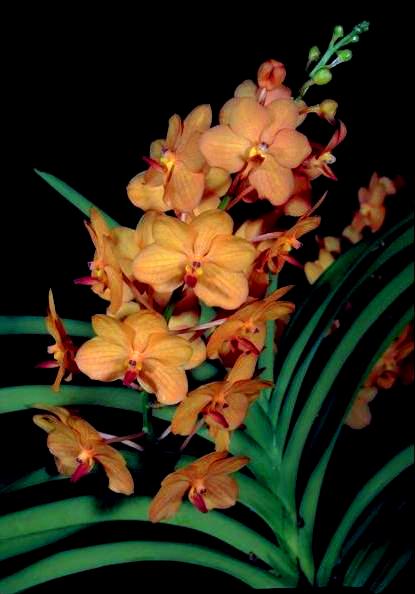
Vanda Meda Arnold 'Caramel' HCC/AOS, same photo adjusted to conform better to the description
May 22, 1972, Long Beach
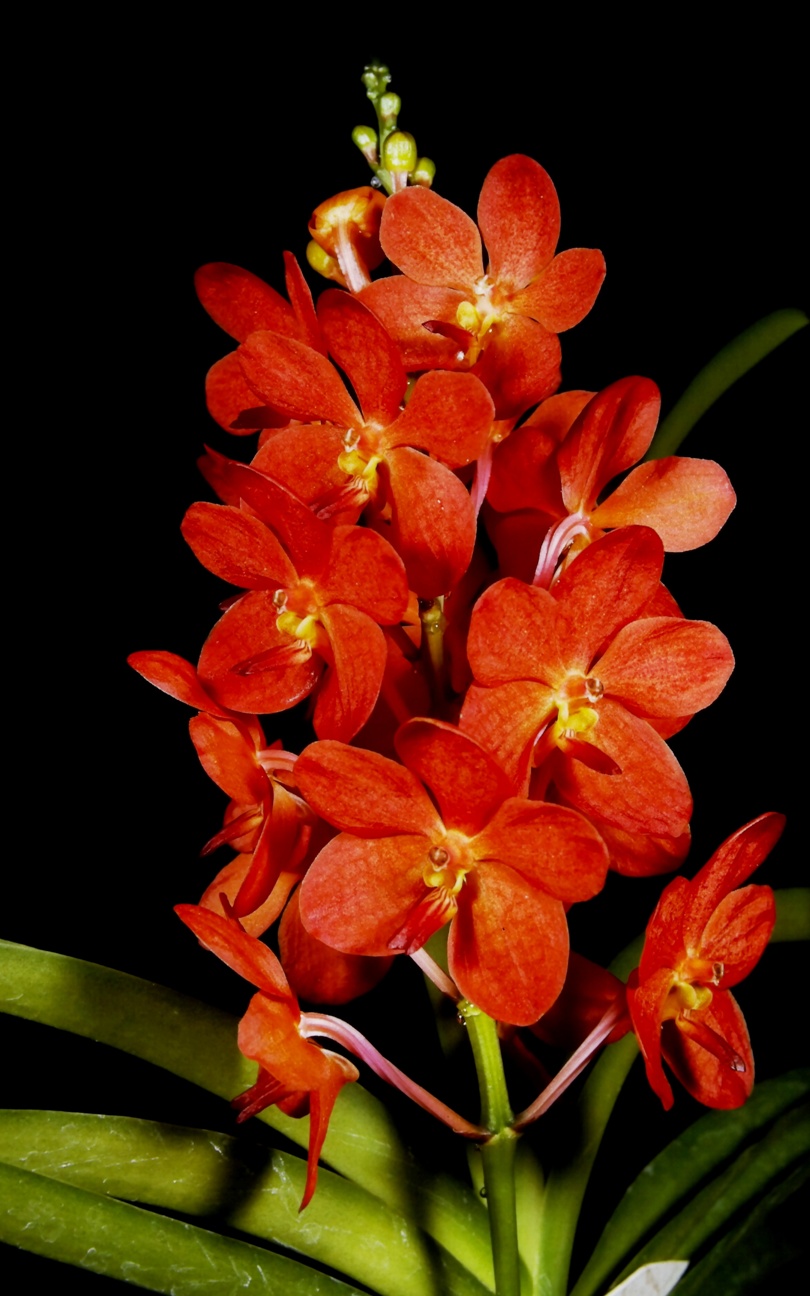
Ascda. Ophelia 'Red Torch' HCC/AOS, new scan from Pacific South award slides
197 Ascda. Ophelia 'Red Torch', HCC/AOS 75.8 points, Norito Hasegawa. Now correctly Vanda Ophelia. Should be AOS Award No. 19720291. Not found in OrchidPro. However, OrchidWiz has the correct information under this number. Published in AOS Bulletin 42(1):65, January, 1973, and Awards Quarterly 4(1):18 (1973) with black and white photo, with all information correct, with award number 72-291. Award text (OrchidWiz, copied from Awards Quarterly): "Fifteen flowers, eleven buds on one spike; brilliant-red tepals with slightly darker tessellation; lip maroon with yellow-green side lobes", exhibitors Dr. and Mrs. Norito Hasegawa, Orange, CA.
August 13, 1973, Los Angeles
AOS Award No. 19730572 Vanda Piswong 'Amethyst Clouds', HCC/AOS 77 points, Norito and Joyce Hasegawa. OrchidPro has complete information but lacks photo.
October 8, 1973, Los Angeles
AOS Award No. 19730645 Rhynchovanda Wong Yoke Sim 'Lisa's Pink', HCC/AOS 77 points, Norito Hasegawa. OrchidPro has complete information but lacks photo.
AOS Award No. 19730646 Blc. Dancing Sunlight 'Touch of Lime', HCC/AOS 76 points, Norito Hasegawa. OrchidPro has complete information but lacks photo. Now correctly a Rhyncholaeliocattleya.
November 26, 1973, Long Beach
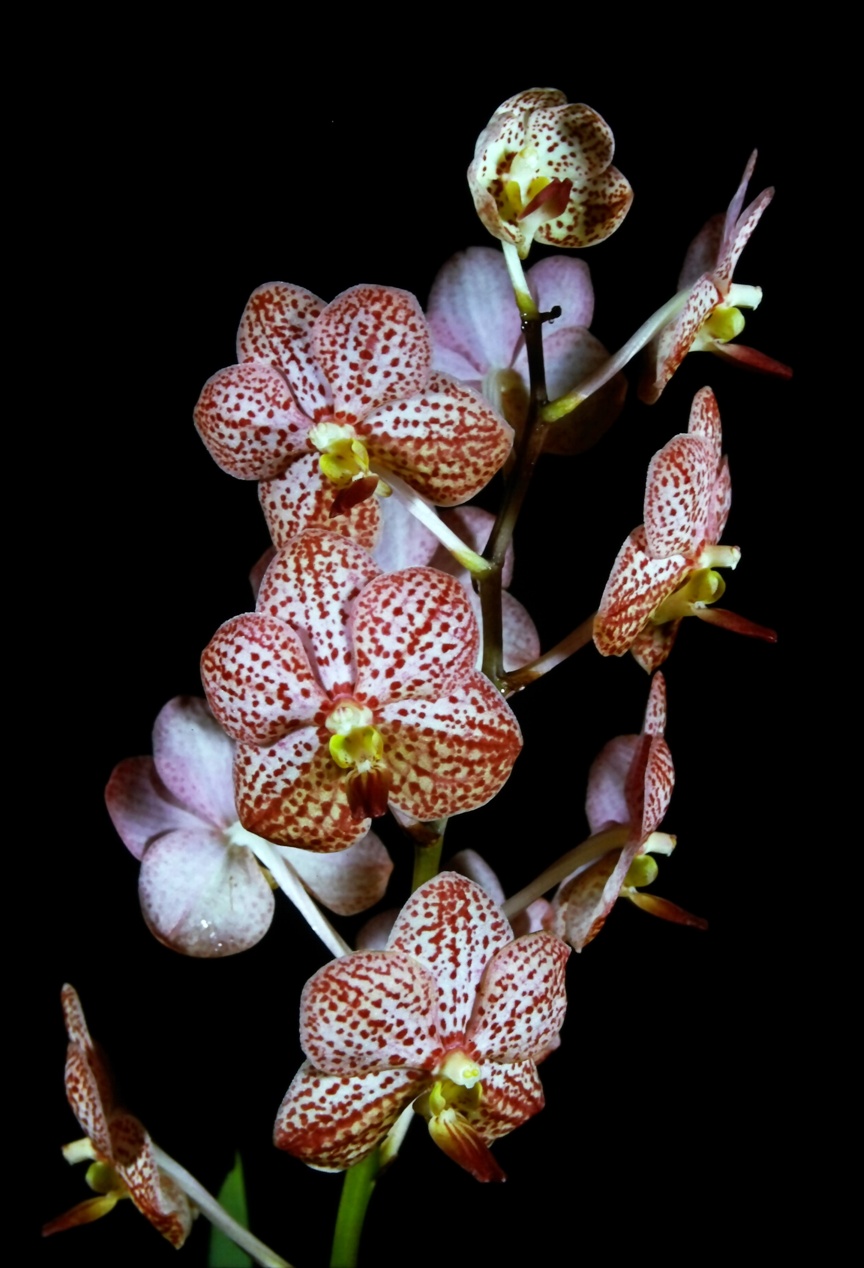
Vanda Bonanza 'Star Spangled Banner' HCC/AOS, new scan from Pacific South award slides
___ Ascda. Bonanza 'Star Spangled Banner', HCC/AOS 75.62 points, Norito Hasegawa. Now correctly Vanda Bonanza. AOS Award No. 19730662. OrchidPro has complete information but no photo. Published in AOS Bulletin 44(10):915, October, 1975, and Awards Quarterly 6(1):5 (1975) without a photo. Award text: "Twelve flowers on one spike; dusky pink background on tepals with overall deep rose spotting; lateral sepals chartreuse, overlay on lower half; lip magenta, side lobes and throat chartreuse", exhibitor Dr. Norito Hasegawa, Orange, CA.
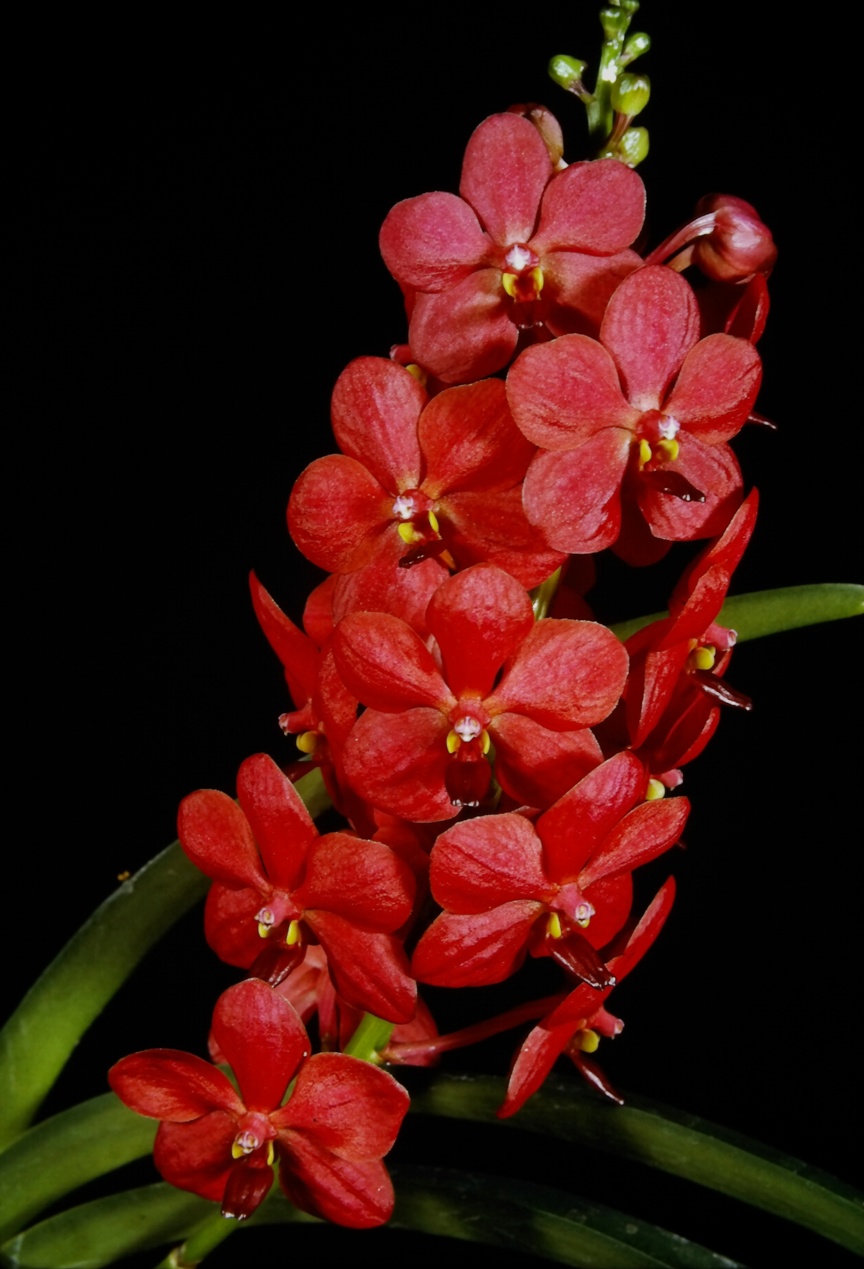
Vanda Memoria Jim Wilkins 'Midnight Flame' HCC/AOS, new scan from Pacific South award slides
___ Ascda. Mem. Jim Wilkins 'Midnight Flame', HCC/AOS 75.0 points, Norito Hasegawa. Now correctly Vanda Memoria Jim Wilkins. AOS Award No. 19730663. OrchidPro has complete information but no photo. Published in AOS Bulletin 44(10):916, October, 1975, and Awards Quarterly 6(1):5 (1975) without a photo. Award text: "Eighteen flowers of good substance and nine buds; dark raspberry red tepals with darker lip and yellow side lobes", exhibitor Dr. Norito Hasegawa, Orange, CA.
February 25, 1974, Long Beach
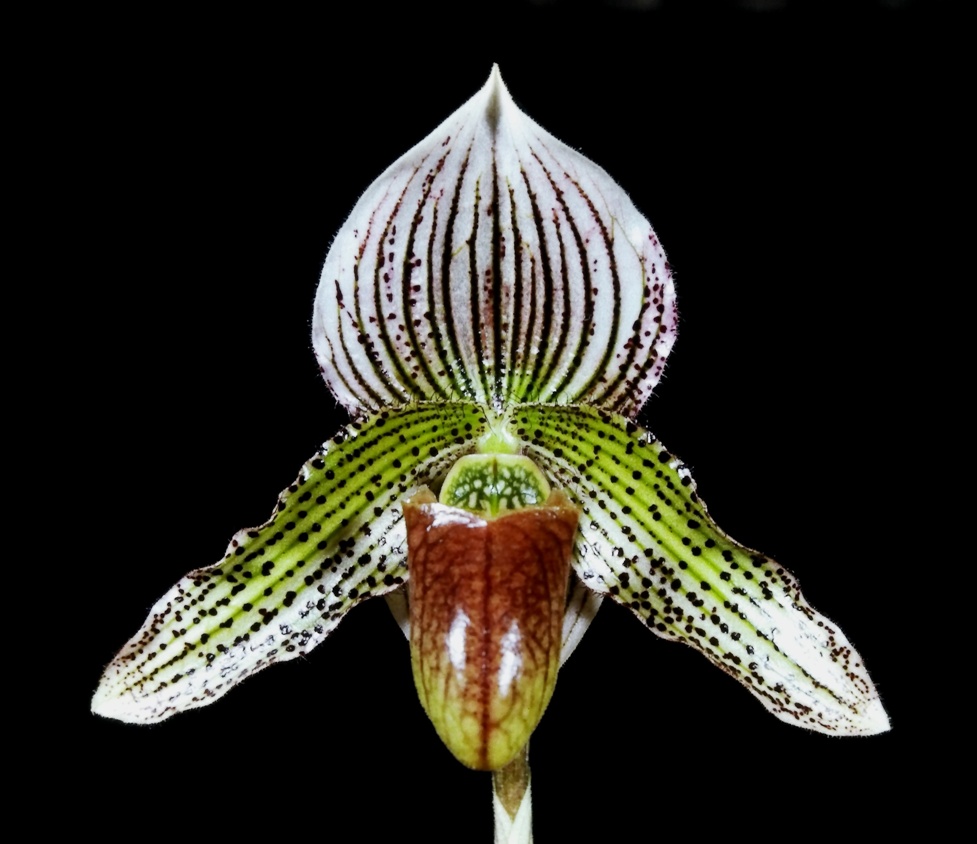
Paphiopedilum Papa Röhl 'Giraffe' HCC/AOS, new scan from Pacific South award slides
AOS Award No. 19740253 Paphiopedilum Papa Röhl 'Giraffe', HCC/AOS 77 points, Norito and Joyce Hasegawa. Published in Awards Quarterly 6(2):36 (1975) without a photo.
August 12, 1974, Los Angeles
AOS Award No. 19740586 Ascocenda Yip Sum Wah 'Burning Sun', HCC/AOS 76 points, Norito Hasegawa.
August 26, 1974, Long Beach
AOS Award No. 19740593 Vanda Peggy Foo 'Violets Are Blue', HCC/AOS 78 points, Norito Hasegawa. Published in Awards Quarterly 6(4):90 (1975) without a photo. This hybrid was originally registered as an Ascocenda in 1970. Photo not found in Pacific South award slide collection.
AOS Award No. 19740594 Vanda Bonanza 'Hot Pink', HCC/AOS 77 points, Norito Hasegawa. Published in Awards Quarterly 6(4):90 (1975) without a photo. This hybrid was originally registered as an Ascocenda in 1970. Photo not found in Pacific South award slide collection.
February 10, 1975, Los Angeles
AOS Award No. 19750184 Ascocenda Peggy Foo 'Pennies from Heaven', HCC/AOS 75 points, Norito Hasegawa. Published in Awards Quarterly 6(4):90 (1975) without a photo. This hybrid was originally registered as an Ascocenda in 1970. Photo not found in Pacific South award slide collection.
March 7, 1975, Santa Barbara International Orchid Show
AOS Award No. 19750636 Phalaenopsis Carmen Coll 'Pink Zebra', AM/AOS 80 points, Norito Hasegawa.
AOS Award No. 19750654 Ascocenda Medasand 'California Orange', HCC/AOS 76 points, Norito Hasegawa.
April 4, 1975, San Diego County Orchid Society Show
AOS Award No. 19750760 Vanda Ella Freed 'Lemon Drops', HCC/AOS 79 points, Norito Hasegawa.
April 28, 1975, Long Beach
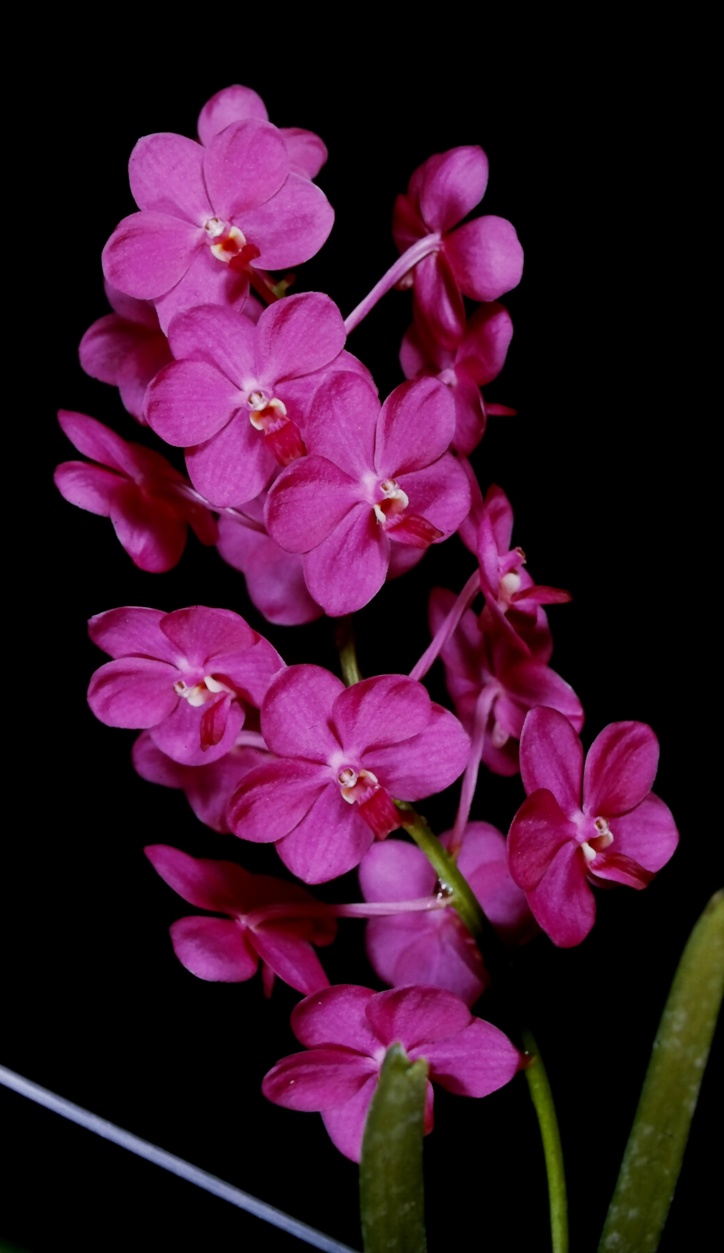
Vanda Peggy Foo 'Ultraviolet' HCC/AOS, new scan from Pacific South award slides
AOS Award No. 19750460 Vanda Peggy Foo 'Ultraviolet', HCC/AOS 76 points, Norito Hasegawa. Published in Awards Quarterly 7(4):94 (1976) without a photo. In OrchidPro, 19750460 is labeled as Vanda Peggy Foo 'Ultraviolet', April 28, 1975, exhibitor Dr. Norito Hasegawa, at Pacific South Supplemental Monthly Judging, Long Beach, CA. However, the description for this award in OrchidPro includes text for three separate plants: (1) "Eleven flowers with white background entirely marked with concentric maroon markings, two spikes; lip bright thistle, side lobes maroon; substance exceptionally heavy, texture excellent"; (2) "Eighteen flowers of overlapping form and good substance, one spike; tepals a moderate purple-red, lip purple with yellow side lobes"; and (3) "One spike with one bloom; deep fire engine red shading to bright orange with overlay of red suffusion; bright red lip". The second plant mentioned in the description matches the description in OrchidWiz of award 19750955, Vanda Peggy Foo 'Ultraviolet', but the award date is listed as April 28, 1976, thus repeating the typographical error in Awards Quarterly 7(4):94-95 (1976). In OrchidPro, the award 19750955 does not exist. The third plant matches the description of Masdevallia Falcata 'Signal', see above, first item in March 24, 1975 awards and in OrchidPro as Award No. 19750928. The first plant turns out to be Phalaenopisis Natasha 'Eye Dee', see above, in the group for March 24, 1975, in OrchidPro as Award No. 19750926.
August 25, 1975, Long Beach
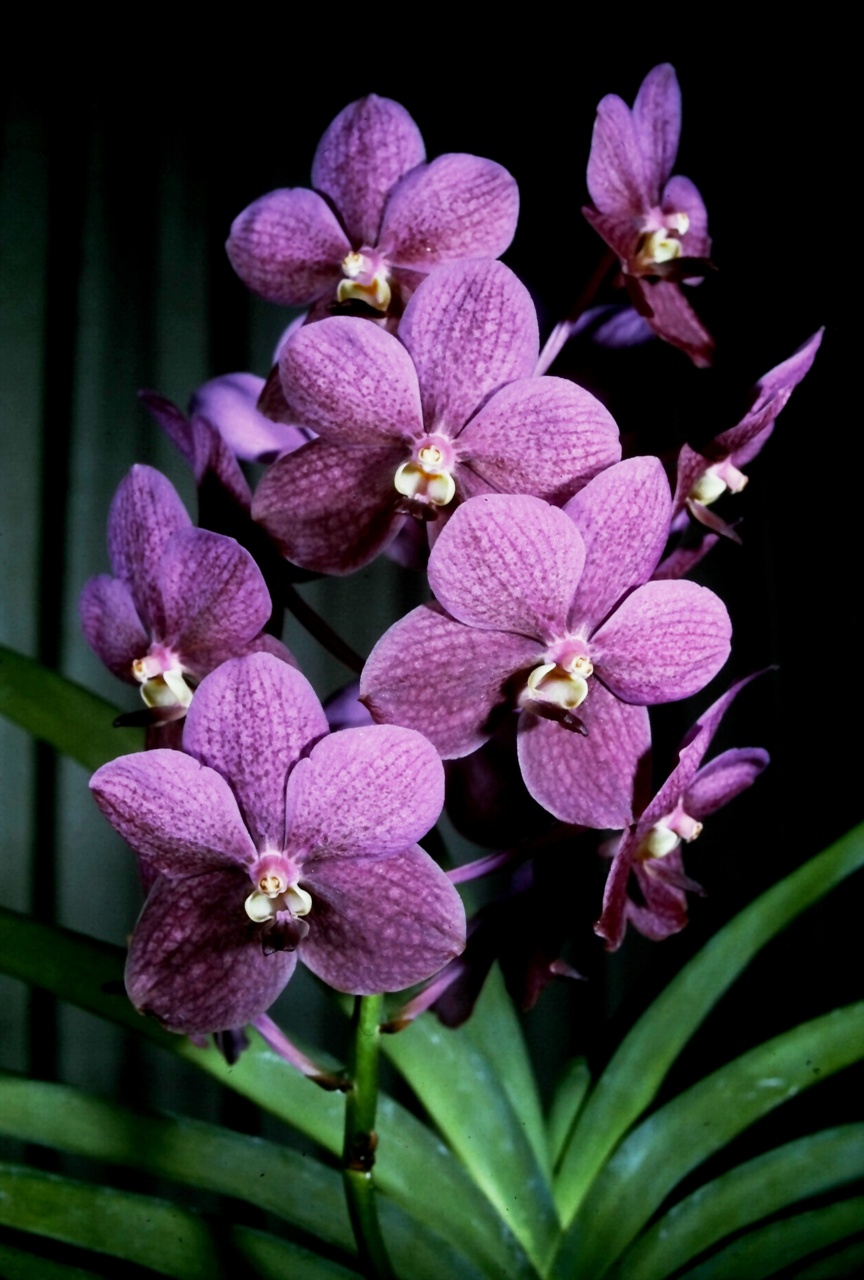
Vanda Mangkiatkul 'Ultra Violet' HCC/AOS, new scan from Pacific South award slides
AOS Award No. 19750681 Vanda Mangkiatkul 'Ultra Violet', HCC/AOS 77 points, Norito Hasegawa. Published in Awards Quarterly 8(3):118 (1977) without a photo. This hybrid was originally registered as an Ascocenda in 1968.
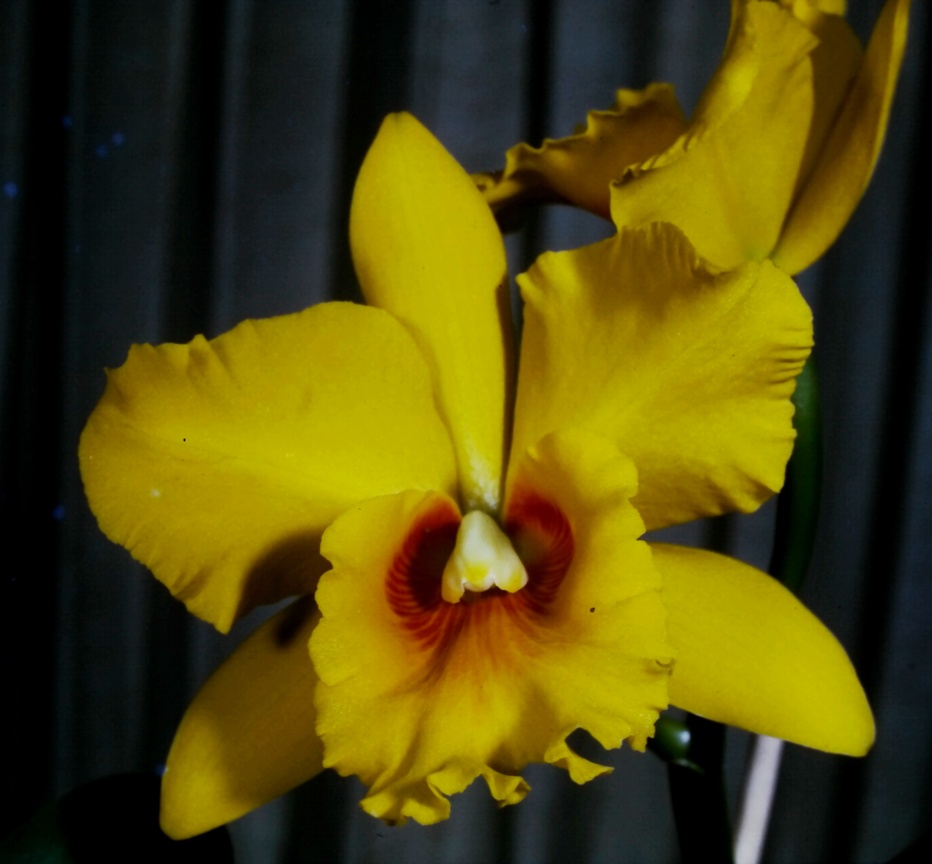
Rhyncholaeliocattleya William Stewart 'Sunny Side Up' HCC/AOS, new scan from Pacific South award slides
AOS Award No. 19750682 Rhyncholaeliocattleya William Stewart 'Sunny Side Up', HCC/AOS 77 points, Norito Hasegawa. Published in Awards Quarterly 8(3):118 (1977) without a photo. This hybrid was originally registered as a Brassolaeliocattleya in 1973.
October 27, 1975, Long Beach
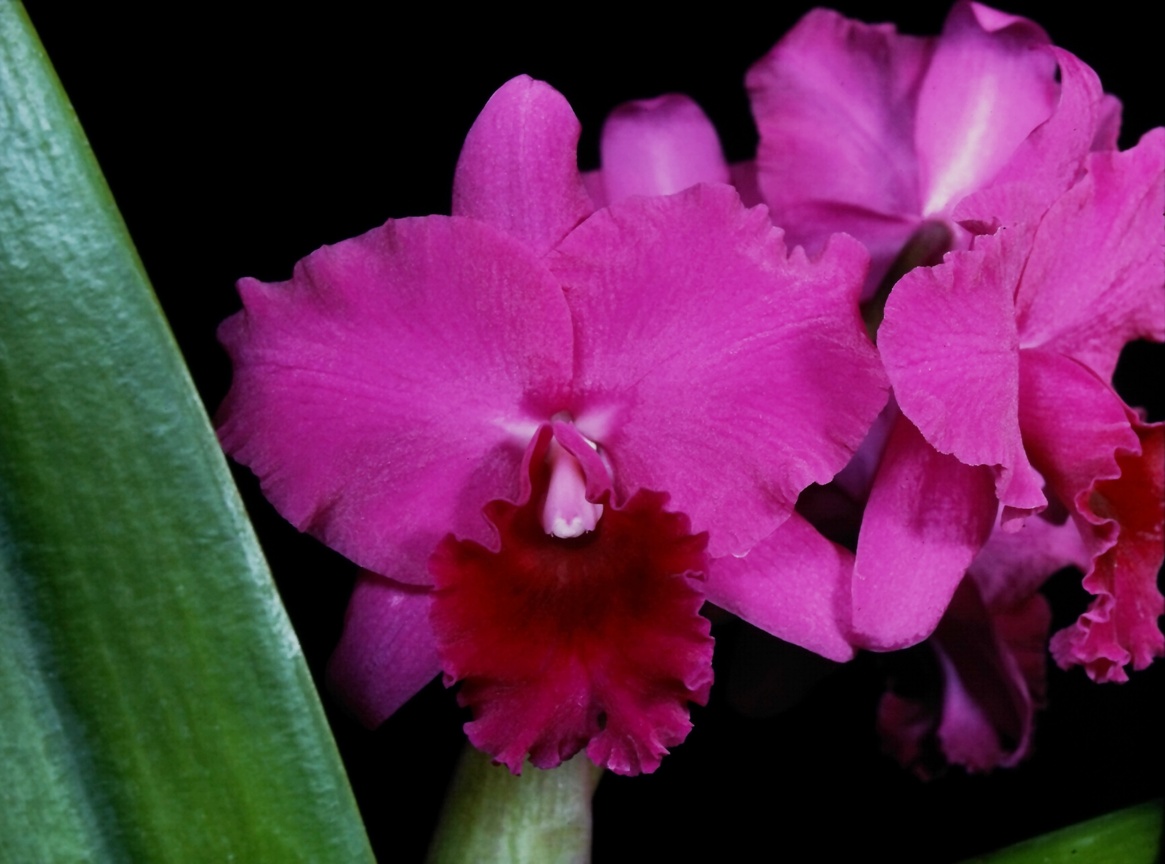
Laeliocattleya Louise Farrell 'Midnight Velvet' HCC/AOS, new scan from Pacific South award slides
AOS Award No. 19750896 Laeliocattleya Louise Farrell 'Midnight Velvet', HCC/AOS 79 points, Norito Hasegawa. Published in Awards Quarterly 8(1):24 (1977) without a photo. This hybrid is now correctly a Cattlianthe
February 9, 1976, Los Angeles
AOS Award No. 19760269 Ascocenda Medasand 'Apricot Glaze', HCC/AOS 77 points, Norito Hasegawa.
March 26, 1976, Santa Barbara International Orchid Show
AOS Award No. 19760554 Paphiopedilum Erma Schulda 'Crucifix', HCC/AOS 78 points, Norito Hasegawa.
May 10, 1976, Los Angeles
AOS Award No. 19760525 Ascocenda Peggy Foo 'Ballyhoo', HCC/AOS 75 points, Norito Hasegawa.
July 12, 1976, Los Angeles
AOS Award No. 19760692 Ascocenda Ophelia 'Bright Sun', HCC/AOS 76 points, Norito Hasegawa.
July 26, 1976, Long Beach
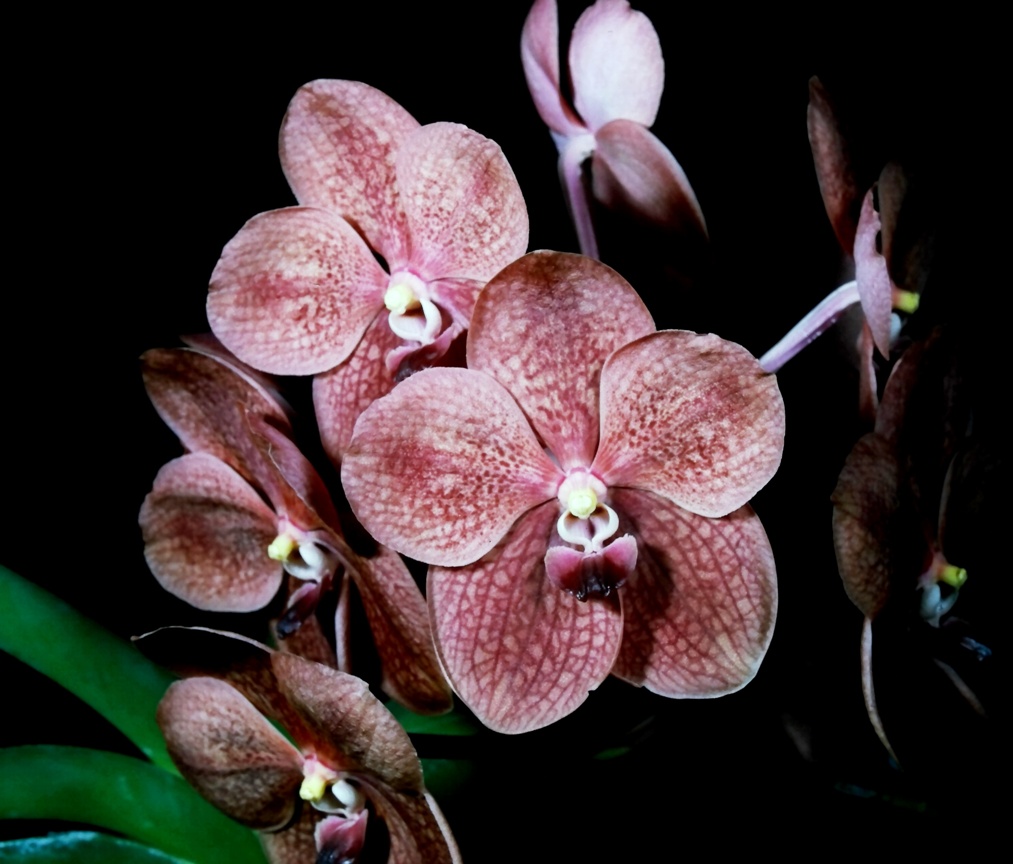
Vanda Hilo Queen 'Hawaiian Dawn' HCC/AOS, new scan from Pacific South award slides
AOS Award No. 19760673 Vanda Hilo Queen 'Hawaiian Dawn', HCC/AOS 78 points, Norito Hasegawa. Published in Awards Quarterly 8(3):110 (1977) without a photo.
January 10, 1977, Los Angeles
AOS Award No. 19770043 Paphiopedilum fairrieanum 'Red Hat', HCC/AOS 76 points, Norito Hasegawa.
January 20, 1977, Long Beach (but judging was held at Paul Brecht's nursery in Costa Mesa)
AOS Award No. 19770318 Paphiopedilum ciliolare 'Stand Tall', HCC/AOS 76 points, Dr. Norito Hasegawa. Published in Awards Quarterly 9(1):22 (1978) without a photo. (Date and venue are incorrect in OrchidPro, which attributes this award to Mid-Atlantic Center Monthly Judging on February 2, 1977!) Photo not found in Pacific South award slide collection.
March 14, 1977, Los Angeles
AOS Award No. 19770269 Paphiopedilum Silver City 'Snowfall', HCC/AOS 77 points, Norito Hasegawa.
May 9, 1977, Los Angeles
AOS Award No. 19770513 Ascocenda Ella Freed 'Kassimatis Gold', HCC/AOS 77 points, Norito Hasegawa.
June 13, 1977, Los Angeles
AOS Award No. 19770661 Phalaenopsis Zuma Beauty 'Ron Allenqui', HCC/AOS 77 points, Norito Hasegawa.
June 27, 1977, Long Beach
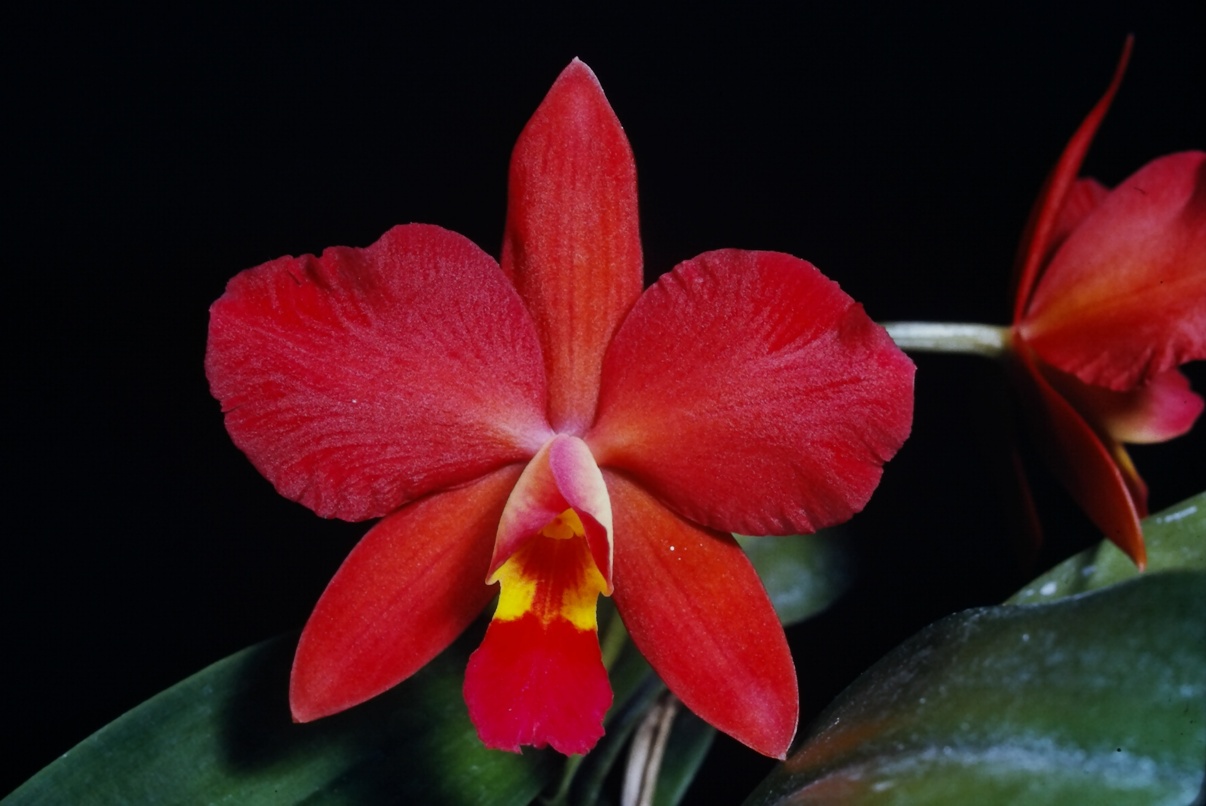
Cattleya Cherry Pie 'Piping Hot' AM/AOS, new scan from Pacific South award slides
AOS Award No. 19770563 Cattleya Cherry Pie 'Piping Hot', AM/AOS 82 points, Norito Hasegawa. Published in Awards Quarterly 9(4):111 (1978) with black and white photo. This hybrid was originally registered as an Sophrolaeliocattleya in 1970.
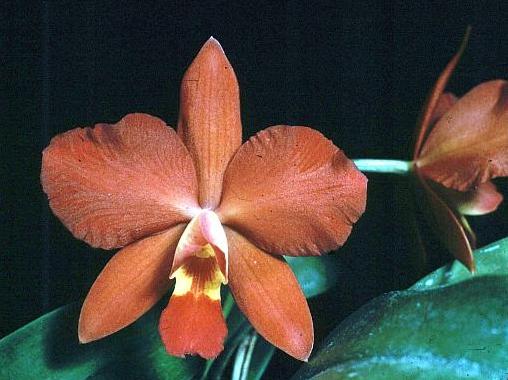
Cattleya Cherry Pie 'Piping Hot' AM/AOS, photo from OrchidPro
August 8, 1977, Los Angeles
AOS Award No. 19770735 Blc. Butterfield Stage 'Golden Bull's-eye', HCC/AOS 78 points, Norito Hasegawa.
AOS Award No. 19770739 Paphiopedilum Bengal Lancers 'Red Sword', HCC/AOS 78 points, Norito Hasegawa.
August 22, 1977, Long Beach
AOS Award No. 19770834 Paphiopedilum Saint Swithin 'Todd Hasegawa', HCC/AOS 78 points, Norito Hasegawa. Published in Awards Quarterly 9(4):128-129 (1978) without a photo. Photo not found in Pacific South award slide collection.
September 6, 1977, Pacific Central Monthly Judging, San Francisco
AOS Award No. 19770770 Oncidim lanceanum 'Norwalk', HCC/AOS 77 points, Norito Hasegawa.
September 12, 1977, Los Angeles
AOS Award No. 19770997 Blc. Pennsylvania Spring 'Green Sheen', HCC/AOS 77 points, Norito Hasegawa.
AOS Award No. 19770998 Vascostylis Susan 'Sky Blue', HCC/AOS 76 points, Norito Hasegawa.
December 12, 1977, Los Angeles
AOS Award No. 19771046 Paphiopedilum concolor 'Gold Sphere', HCC/AOS 77 points, Norito Hasegawa.
January 9, 1978, Los Angeles
AOS Award No. 19780156 Paphiopedilum Magnate 'Golden Jaguar', HCC/AOS 77 points, Norito Hasegawa.
AOS Award No. 19780163 Paphiopedilum Keyeshill 'Dark Warrior', HCC/AOS 75 points, Norito Hasegawa.
March 27, 1978, Long Beach
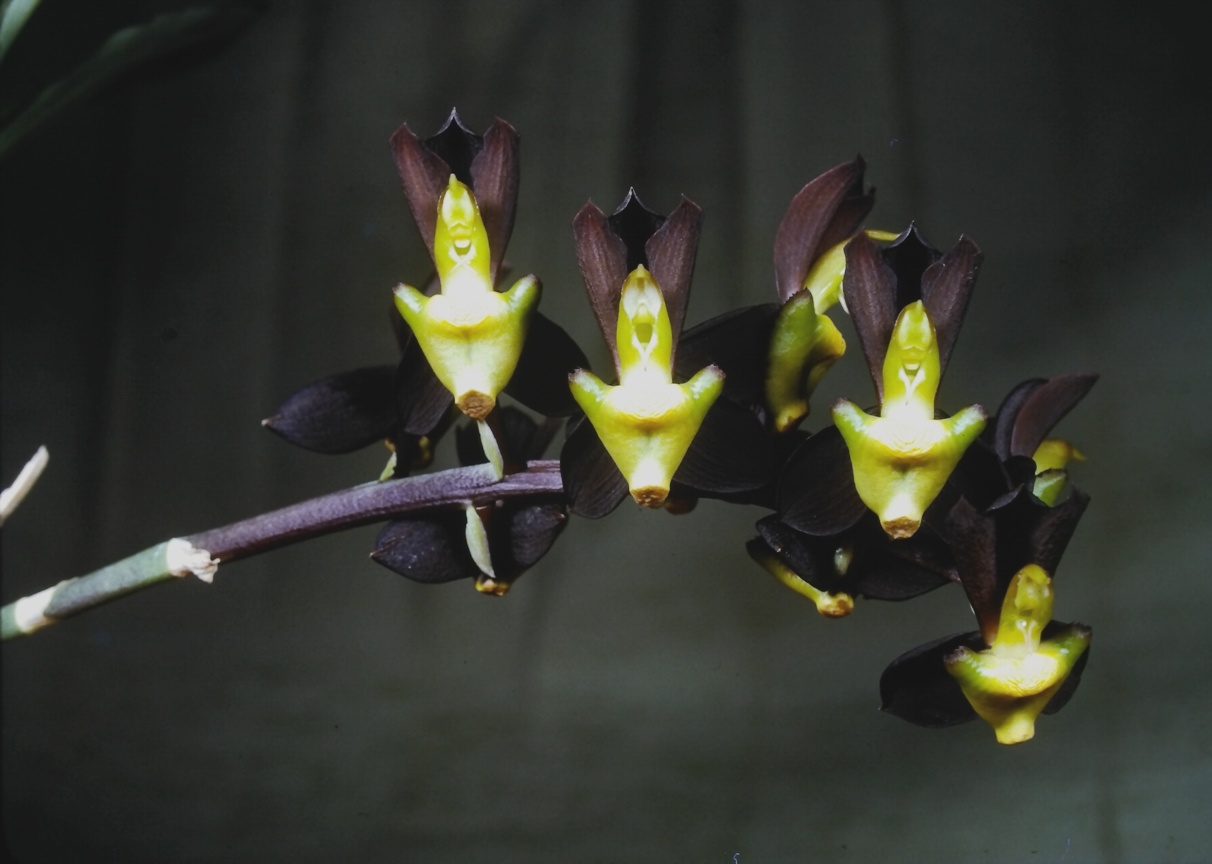
Catasetum tenebrosum 'Charcoal' HCC/AOS, new scan from Pacific South award slides
AOS Award No. 19780357 Catasetum tenebrosum 'Charcoal', HCC/AOS 77 points, Norito Hasegawa. Published in Awards Quarterly 10(3):91 (1979) without a photo.
AOS Award No. 19780359 Vanda Darcey Starr 'Gold Adventure', HCC/AOS 76 points, Norito Hasegawa. Published in Awards Quarterly 10(3):91 (1979) without a photo. This hybrid was originally registered as an Ascocenda in 1971. Photo not found in Pacific South award slide collection.
April 6, 1978, Santa Barbara International Orchid Show
AOS Award No. 19780604 Ascocenda Yip Sum Wah 'How R Ya', HCC/AOS 77 points, Norito Hasegawa.
November 24, 1980, Long Beach
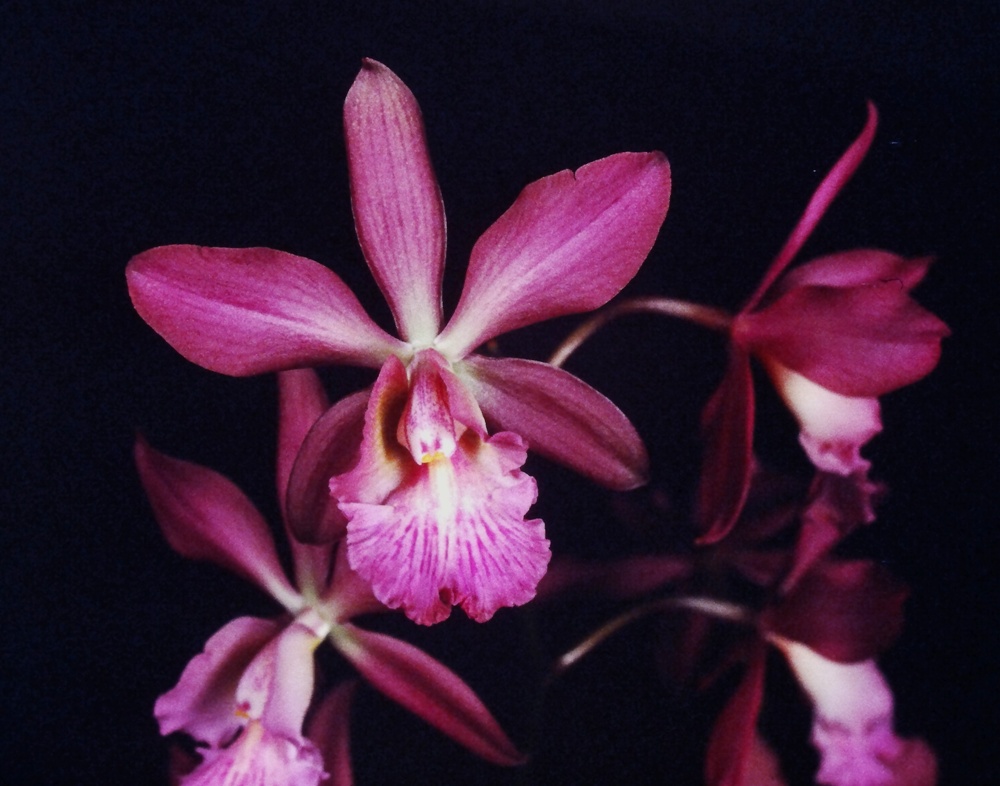
Catyclia Dowsett Gem 'Tall Chief' HCC/AOS, new scan from Pacific South award slides
AOS Award No. 19801305 Catyclia Dowsett Gem 'Tall Chief', HCC/AOS 78 points, Norito Hasegawa. Published in Awards Quarterly 12(4):247 (1981) with black and white photo. This hybrid was formerly an Epicattleya. The deep purple background in the photo attached to this award in OrchidPro alerts us that the color is likely not true in this award photo, or at least, too dark. The description says the sepals and petals are rose-violet with deeper violet venation, "lip cream at base, shading to medium rose-violet at outer edge, central lobe with red-violet venation". We adjusted the contrast and brightness slightly here.

Catyclia Dowsett Gem 'Tall Chief' HCC/AOS, from OrchidPro, with adjustments to contrast and brightness
Copyright 2024 South Coast Orchid Society, Inc.